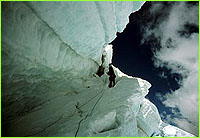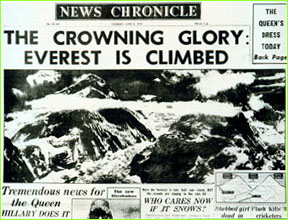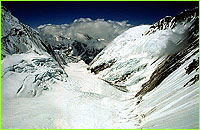
|
 |
 |
First to Summit part 2 | back to part 1  Snow conditions were not good and in places the southeast
ridge narrowed to a knife-edge, but they plodded on slowly and
gained the South Summit by 9 a.m. The looping ridge ahead was
weighed down with heavy snow cornices overhanging the
frightfully steep East, or Kangshung Face. They took stock of
how much oxygen was remaining, and then Hillary led a tricky
and difficult path, avoiding the cornices on one side and
steep slopes on the other. After an hour's steady going they
came to a steep rocky step, some forty feet high. They had
known of this in advance from aerial photographs, but did not
know whether it could be surmounted. Luckily, Hillary found a
crack into which he was able to partly jam his body and
wriggle his way upwards. The obstacle is still called the
Hillary Step today.
Snow conditions were not good and in places the southeast
ridge narrowed to a knife-edge, but they plodded on slowly and
gained the South Summit by 9 a.m. The looping ridge ahead was
weighed down with heavy snow cornices overhanging the
frightfully steep East, or Kangshung Face. They took stock of
how much oxygen was remaining, and then Hillary led a tricky
and difficult path, avoiding the cornices on one side and
steep slopes on the other. After an hour's steady going they
came to a steep rocky step, some forty feet high. They had
known of this in advance from aerial photographs, but did not
know whether it could be surmounted. Luckily, Hillary found a
crack into which he was able to partly jam his body and
wriggle his way upwards. The obstacle is still called the
Hillary Step today.Tenzing followed up behind, and the pair continued their switchback progress along the summit ridge until finally they saw they had passed the last corner. Ahead of them lay only a snowy dome and the vast plateau of Tibet. 'A few more whacks of the ice axe in the firm snow, and we stood on top,' Hillary described later.  Hillary sought to shake hands with his partner, but a
delighted Tenzing would have nothing but to fling his arms
around his friend's shoulders, thumping him on the back. It
was 11.30 a.m. and the highest point on earth had at last been
trodden by man. Hillary sought to shake hands with his partner, but a
delighted Tenzing would have nothing but to fling his arms
around his friend's shoulders, thumping him on the back. It
was 11.30 a.m. and the highest point on earth had at last been
trodden by man.As mentioned, news of the triumph broke around the world on Coronation Day. The achievement was seen as a propitious omen for the forthcoming era of New Elizabethans. Hillary, Tenzing, and Hunt became popular international figures, and throughout the British Commonwealth housing estates and municipal buildings were named after them. Hunt and Hillary received knighthoods from the young queen. Tenzing, regrettably, was awarded the inferior British Empire Medal. All those on the expedition found their lives and careers changed by Everest success. We can be grateful that Hunt's carefully chosen team was universally aware of its privilege and that all the members, in their own way, have sought to use their prestige in public service.  Hunt went on to become The Lord Hunt of Llanvair Warterdine,
known for conspicuous work with young people, for the Pres and
the Parole Board and as an international ambassador. Hillary,
too, has held ambassadorial positions but is best known for
his work with the Himalayan Trust, dedicated to improving the
lot of the Sherpa community in Nepal. Most notable is his help
in establishing the Khumjung School that has served for years
in educating Sherpa children throughout the Khumbu. Tenzing
founded the Indian Mountaineering Federation with an
injunction from President Nehru to `train a thousand
Tenzings'; throughout his life he remained a smiling and
approachable unofficial ambassador for the Sherpa people.
Money earned by the Everest film and the best-selling book of
the expedition was put into the Mount Everest Foundation to
assist future mountaineering projects and has since dispensed
almost $750,000 in grants to over 900 expeditions.
Hunt went on to become The Lord Hunt of Llanvair Warterdine,
known for conspicuous work with young people, for the Pres and
the Parole Board and as an international ambassador. Hillary,
too, has held ambassadorial positions but is best known for
his work with the Himalayan Trust, dedicated to improving the
lot of the Sherpa community in Nepal. Most notable is his help
in establishing the Khumjung School that has served for years
in educating Sherpa children throughout the Khumbu. Tenzing
founded the Indian Mountaineering Federation with an
injunction from President Nehru to `train a thousand
Tenzings'; throughout his life he remained a smiling and
approachable unofficial ambassador for the Sherpa people.
Money earned by the Everest film and the best-selling book of
the expedition was put into the Mount Everest Foundation to
assist future mountaineering projects and has since dispensed
almost $750,000 in grants to over 900 expeditions.As Lord Hunt has said, the success of his team on Everest was merely the continuation of the effort of all those who had gone before. Yet we can feel ourselves fortunate that in him and his team, the world was blessed with men to match the mountains they climbed. Audrey Salkeld of Clevedon, England is one of the world's premier Everest historians and photo researchers. Her photo editing credits include Everest: The Ultimate Book of the Ultimate Mountain and Everest: The Best Writing and Pictures from Seventy Years of Human Endeavour. Photos: (1) courtesy Ed Viesturs; (3) courtesy Robert Schauer. Lost on Everest | High Exposure | Climb | History & Culture | Earth, Wind, & Ice E-mail | Previous Expeditions | Resources | Site Map | Everest Home Editor's Picks | Previous Sites | Join Us/E-mail | TV/Web Schedule About NOVA | Teachers | Site Map | Shop | Jobs | Search | To print PBS Online | NOVA Online | WGBH © | Updated November 2000 |